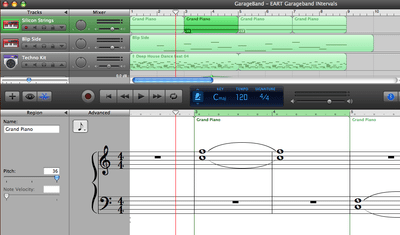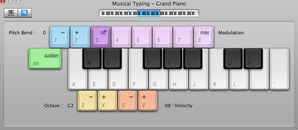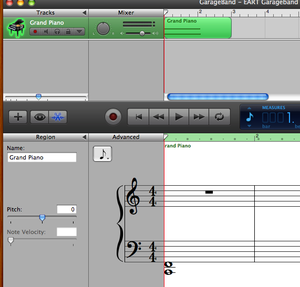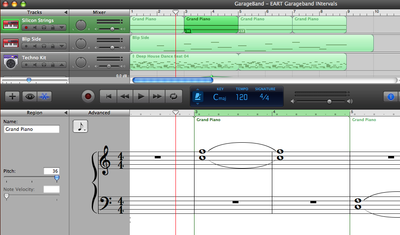Did you know you can make your own interval ear training exercises using Apple’s simple music software Garageband? It’s a great way to mix ear training with creative music production. Record fun music tracks, export them to iTunes, and load them onto your mobile device to practice ear training skills like intervals, chords, note recognition, and rhythm.
One of the fundamental skills in ear training involves recognizing different music intervals. An interval essentially involves two notes in a scale played simultaneously. For example, in the C scale, playing the note C and the note E at the same time consists of an interval of a third (see image).
Get started with Garageband ear training by practicing interval recognition and creating your own interval ear training exercises. Here are the three easy steps:
1. Set up a New Project for Garageband Ear Training
Open a new project in Garageband for your interval ear training. If you do not have a MIDI keyboard hooked up via USB, you can open Musical Typing under the Window menu. Musical Typing allows you to record music using your computer keyboard. You can choose other parameters such as instrument choice, metronome settings, and tempo.
2. Record Your Interval Ear Training Exercises
Select the red Record button to record basic intervals like a major or minor third, perfect fourth or perfect fifth. At first, only record two or three different types of intervals as separate Garageband Projects. If you are more familiar with Garageband, you can save a step by recording all of the intervals on separate tracks in the same project and exporting them later by soloing the different tracks. Play each interval only once initially, leaving a few seconds of silence.
3. Export Your Ear Training Exercises to iTunes
Once you have recorded your interval ear training exercises, export the track to iTunes by selecting “Send Song to iTunes” under the Share menu and choose “MP3 Encoder”. Once your track is exported, you can use iTunes to import your track into your MP3 player. Exporting to iTunes differs depending on the version of Garageband you own. Double check how to export a track if your version of Garageband has different options.
Once you have imported the music interval tracks into your MP3 player, you can practice your intervals by shuffling them, listening to them, and guessing which interval is being played. Record newer tracks in Garageband using intervals to practice ear training.
Making a Catchy Garageband Interval Mix
Want to add a little bit of fun to interval training? Make your own interval mix in Garageband in a few easy steps. Record a few measures of the interval you are learning. In the audio example, I used a fourth. Change the instrument from piano to any of the hundreds of options available in Garageband.
Experiment with a second high pitched track to improvise a short melody based on the interval you are learning. Add some effects and a few supplementary tracks, and you have a new mix that not only embeds intervals into your mind’s ear with a catchy mix but shows off your awesome music production chops, too!
Garageband is an easy-to-use and highly versatile Digital Audio Workstation (DAW). This makes it the perfect environment for creating your own ear training projects. You can use it on a Mac or even on an iPad. Discover more creative ideas for using Garageband for music learning at Midnight Music.
Garageband ear training is a perfect way to use technology creatively to help you train your musical ears in a fun and effective way. Start with the simple interval ear training exercises described above, and then develop your own projects and ideas for developing your ears with Garageband!











when writing a melodie for e.g. a third, should I only go up and down a thrid every time I change the note or should I only stick to the Notes e.g. C & E in different octaves?
Hi Gert,
If you keep moving in thirds you will probably create quite an odd-sounding melody, because you’ll quickly be using notes from outside the key.
It’s probably best to choose a particular key (e.g. C Major), and then identify the different examples of an interval you can find in that key. For example, in C Major you can find major thirds C-E, F-A and G-B. You could create practice melodies using just one of these pairs of notes in different octaves, or using a mix of the note pairs, a bit like the fourths example above.
Does that help?